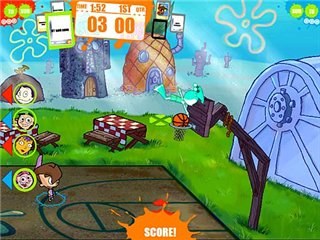
Identifying with Nickelodeon became so easy because kids could so easily identify a Nickelodeon show. Despite initially small budgets and limited space, each show leaned into its interactive, tactile environment, epitomizing Nick’s commitment to kid-inspired entertainment and hooking a generation in the process. Between the surrealist obstacle courses on Double Dare, the multitiered rock formations on Legends of the Hidden Temple, and the spontaneous slime on Figure It Out, Nickelodeon boasted a fantastical, eye-popping aesthetic that distinguished it from every other network. Throughout the late 1980s and 1990s, that same kind of colorful anarchy and wacky set design saturated the best of Nickelodeon’s live-action programming.

The Best Nickelodeon Character Bracket: Round 2 “We got to use a lot of neon,” Taylor says. Why not be inside one?” The mazelike imagery even appeared on the interactive portions of the game, which included a makeshift putting green with bright pink golf balls and a primary-colored, numbered keypad for the show’s finale. We were playing games on these giant, rear-projection televisions. “But I saw a piece of clip art-a photograph of circuit boards in an electronic magazine– all the transistors, diodes, and LED lights, and it looked stunning. “We really didn’t have a strong idea for that visually,” says Byron Taylor, Nickelodeon’s head production designer. Behind Pittman and the other jumpsuited contestants, stadium-style scoreboards overflowed with rainbow-colored wires while computer-like designs surrounded the blue-and-red-lit backdrops.

Indeed, Get the Picture provided a visual feast for those tuning in. “It was very mechanical and had this tech vibe to it.

“There were these colorful tubes and lights everywhere,” Pittman says. Soon, she was shaking hands with O’Malley and taking in the sights and sounds of the stage, overwhelmed by its distinct shapes and patterns. For a teenage theater kid who’d grown up on Nickelodeon, the opportunity to be on television and peek behind the curtain of one of her favorite shows was “eye opening and fascinating for me,” she says.Īfter arriving at Nickelodeon Studios, inside Universal Studios’ theme park in Orlando, Pittman battled her nerves and slipped into the show’s required lemon-colored outfit-“like we were going onto a construction site,” she says with a laugh.
#Nicktoons basketball teams series#
Hosted by Mike O’Malley, the program featured two teams competing to answer trivia questions before decoding a series of hidden images from a large, 16-monitor screen. In the spring of 1991, the middle-schooler from Northwest Orlando had been selected by a Nickelodeon casting director to appear on the network’s new game show, Get the Picture. Tiffany Pittman mostly remembers the yellow jumpsuit. Throughout the week, we’ll be publishing essays, features, and interviews to get at the heart of what made Nick so dang fun-and now so nostalgic. To mark the anniversary, The Ringer is looking back at Nick’s best-ever characters and the legacy of the network as a whole. Introduced on August 11, 1991, under the brand of “Nicktoons,” Doug, Rugrats, and The Ren & Stimpy Show would quickly become hits and change the course of animation, television, and popular culture at large.

Thirty years ago this week, a rising but not-yet-ubiquitous kids network by the name of Nickelodeon launched its first original animated series.


 0 kommentar(er)
0 kommentar(er)
